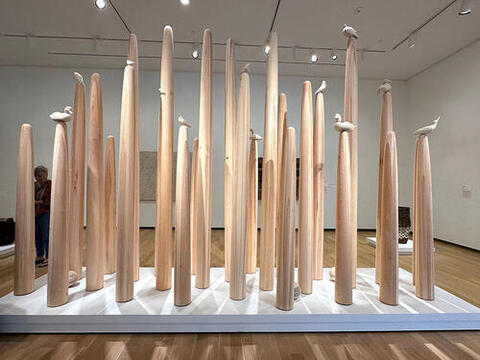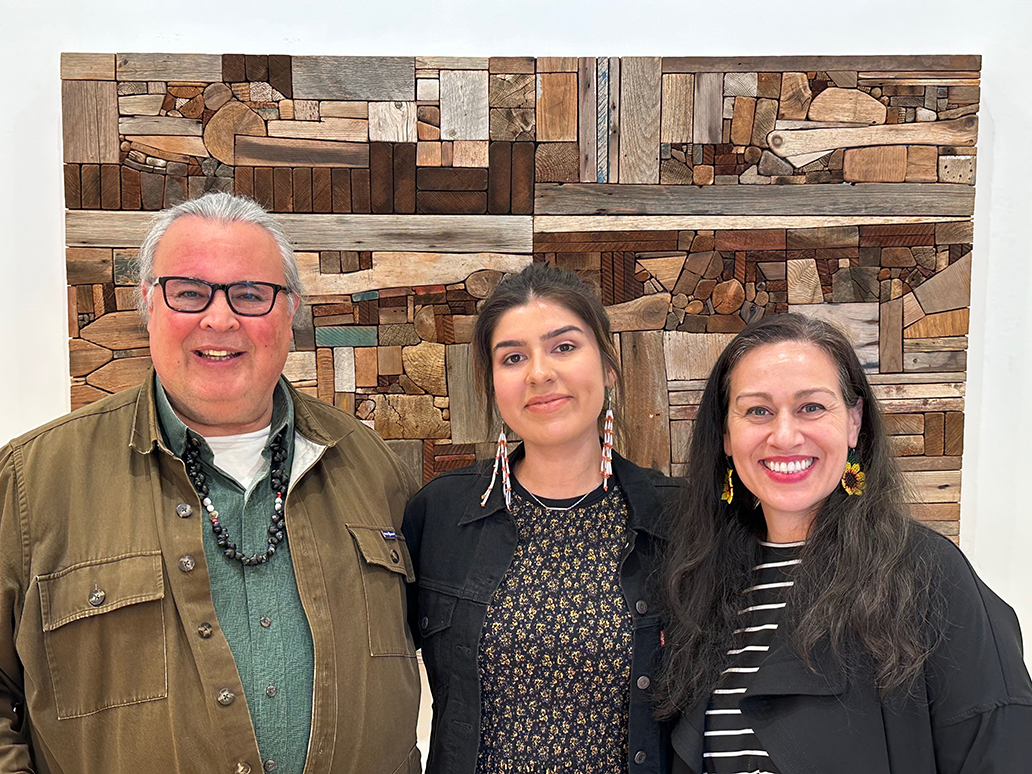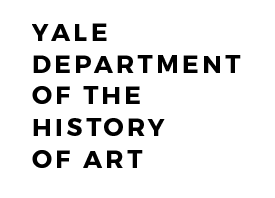Graduate student curates major exhibition “Smoke in Our Hair”

Graduate student curates major exhibition “Smoke in Our Hair”
Graduate student Sháńdíín Brown (Diné) has curated a major exhibition of recent and contemporary work by twenty-two Native American Artists titled “Smoke in Our Hair.” The exhibition, on view at the Hudson River Museum in Yonkers, New York, until 31 August, has been hailed by the New York Times as gathering together artists “who rewrite the land as contested, communal and charged with memory.” Sháńdíín, the Times continues, belongs to “a new wave of curators … who reframe Native art not as artifact but as argument.” The exhibition was selected by the Times as “Critic’s Pick.”
“Smoke in Our Hair.” ranges widely across the geographies of north America, gathering Native American, Alaska Native, First Nations, and Métis artists, all of whom (the exhibition’s website explains) “carry forward the artistic lineages of their ancestors while simultaneously sparking new visions of the future.” The exhibition is shaped in three sections—wood, fire, and smoke—each seen against the backdrop of a plate-glass river revealing the Hudson River itself, known to Mohican people as Mahicannituck, the waters that flow both ways. The insights in “Smoke in Our Hair” differ profoundly from those in the exhibition’s permanent galleries, where settler-colonial paintings of the “Hudson River School” which impose European conventions of representation.
For the title, Sháńdíín turned to the poem “Smoke in Our Hair” by Ofelia Zepeda (Tohono O’odham). She writes: “Smoke, like memories, permeates our hair,/ our clothing, our layers of skin./ The smoke travels deep/ to the seat of memory./ We walk away from the fire;/ no matter how far we walk,/ we carry this scent with us.”
Many of the works on display have an olfactory as well as a powerful visual and material presence. A slight odor of weathered wood draws the visitor to a work central to the installation, Collage × Landscape, 1975. This panoramic landscape composition was formed from weathered wood by George Morrison (Ojibwe, 1919–2000), a foundational figure in Native American modernism. Morrison’s work explores the rings and striations of timber, but this is no hymn to nature: Morrison assembled the piece from the flotsam of discarded planks and blocks machine-cut discarded by the mills surrounding Lake Superior, the huge body of water known by Ojibwe people as gichi-gami or Great Sea, on whose north shore Morrison lived for many years.
On April 26, the museum held a study day “Landscape of Abstraction: George Morrison’s Legacy,” in which Sháńdíín was joined by panellists Anya Montiel (Mestiza/Tohono O’odham, who earned her PhD at Yale in History of Art and American Studies and is now curator at the Smithsonian National Museum of the American Indian) and distinguished scholar and curator Scott Manning Stevens (Akwesasne Mohawk) [see image 2]. The conversations explored the poetics and politics of Morrison’s work in relation to Institutional histories of exclusion; he emerges in “Smoke in Our Hair” as a major figure in post-War American art.

Sháńdíín Brown (Diné), center, with Anya Montiel (Mestiza/Tohono O’odham) PhD 2018, right, and Prof Scott Manning Stevens (Akwesasne Mohawk), left, with Collage × Landscape, 1975 by George Morrison.
In the exhibition, Morrison’s work is movingly juxtaposed with a major contribution, Never-Ending Monument (2021) by a prominent younger artist who readily acknowledges his influence, Andrea Carlson. This sculptural installation, made up of effigy staffs, engages with landscape (as the exhibition label explains) “as a repository of memory and meaning, while also exploring perspective, the horizon, and the body’s shifting sense of space.” Carlson’s imposing structure responds to the Man Mound, a massive earthwork created by Late Woodland peoples (600–900 CE) in Wisconsin. In a powerful curatorial move, Carlson’s bold procession effigy staffs is placed in dialogue with wall-mounted works by Morrison.
Each of the three sections of “Smoke in Our Hair” offers rich contrasts and artistic methods, materials and strategies. But collectively the exhibition reflects on time, history and memory, insisting above all on the constant and generative presence of Indigenous people and the distinctive, powerful contribution of their visual and material art in the present.
